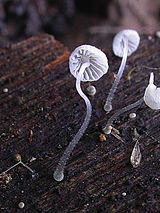- Mycena adscendens
-
Mycena adscendens 
Scientific classification Kingdom: Fungi Division: Basidiomycota Class: Agaricomycetes Order: Agaricales Family: Mycenaceae Genus: Mycena Species: M. adscendens Binomial name Mycena adscendens
(Lasch) Maas Geest. (1981)Synonyms[1] Agaricus adscendens Lasch (1829)
Agaricus tenerrimus Berk. (1836)
Mycena tenerrima (Berk.) Sacc.
Mycena tenerrima (Fr.) Quél. (1874)
Prunulus tenerrimus (Berk.) Murrill (1916)
Pseudomycena tenerrima (Berk.) Cejp (1930)Mycena adscendens Mycological characteristics 
gills on hymenium 
cap is conical 
hymenium is adnate 
stipe is bare 
spore print is white 
ecology is saprotrophic 
edibility: unknown Mycena adscendens, commonly known as the frosty bonnet, is a species of fungus in the Mycenaceae family. The fungus produces small fruit bodies (mushrooms) with caps up to 3.5 mm (0.14 in) in diameter, supported by thin stems up to 2 cm (0.8 in) long. It is distributed in the United States, where it has been found from Washington to California, Europe, and Turkey. The fruit bodies grow in fallen twigs and other woody debris, including fallen hazel nuts. The variety carpophila has been found in Japan.
Contents
Taxonomy
The species was originally named Agaricus adscendens by Wilhelm Gottfried Lasch in 1829.[2] It was Dutch mycologist Maas Geesteranus who assigned the species its current name in a 1981 publication.[3] According to the taxonomic authority Index Fungorum, Miles Berkeley's 1836 Agaricus tenerrimus[4] is the same species as Mycena adscendens, as well as all later synonyms based on this basionym: Mycena tenerrima (Berk.) Quél. 1872; Prunulus tenerrimus (Berk.) Murrill 1916; and Pseudomycena tenerrima (Berk.) Cejp 1930.[1] Other authorities treat the species as independent.[5][6]
The mushroom is commonly known as the "frosty bonnet".[7] The specific epithet adscendens is derived from the Latin word for "ascending".
Description
The cap is white and small, with a diameter typically ranging from 0.25 to 0.75 cm (0.1 to 0.3 in). Initially convex to cucullate (hood-shaped), it flattens during maturity, developing visible surface grooves that correspond to the gills underneath the cap; the surface may also be covered with glistening particles, remnants of the partial veil.[8] The cap color is pallid gray with a whitish margin when young, but soon becomes white overall. The flesh is membranous and fragile. The gills are free or attached to the stem by a line; they are broad, distantly-spaced, sometimes adhering to each other to form a slight collar around the stem, and white throughout their development. The stem is 0.5 to 2 cm (0.2 to 0.8 in) long, and usually curved and threadlike. The base is enlarged into a slight bulb, which is initially nearly spherical.[9]
The variety carpophila is characterized by its white cap up to 1 mm in diameter, and narrowly conical caulocystidia (cystidia found on the stem).[10]
Microscopic characteristics
The spores are broadly ellipsoid, amyloid, with dimensions of 8–10 by 5–6.5 µm. The basidia (the spore-bearing cells) are two-spored; pleurocystidia may be present or absent. If present, they are similar to the cheilocystidia. The cheilocystidia are abundant, measuring 28–44 by 8–12 µm. They are variable in shape, often fusoid-ventricose or with 2–3 needle-like projections arising from the apex, the projections forked at times, the ventricose portions covered with short rodlike protuberances or merely verrucose. The flesh of the gills is vinaceous-brown when stained in iodine. The flesh of the cap is made up of greatly enlarged cells, with the surface covered with club-shaped to almost globular cells measuring 25–40 by about 20 µm. Their walls are finely verrucose (covered with small warts), and all but of the verrucose cells are vinaceous-brown in iodine.[9]
Similar species
Other Mycenas that resemble M. adscendens include M. alphitophora and M. stylobates. The former is distinguished from M. adscendens by a stem base that is not swollen or disc-like, the latter by its larger and sturdier fruit body.[11]
Habitat and distribution
Fruit bodies of Mycena adscendens are found scattered to grouped together on twigs, bark, and woody debris of conifers and hardwoods during the spring and autumn. They are also found growing on hazel nuts that have fallen to the ground; two other Mycenas known to grow on this substrate include M discopus and M. nucicola.[12] In the United States, it is distributed from Washington to California.[9] It is also found in Europe,[12] and has been collected in Amasya Province, Turkey.[13] The variety carpophila was reported in Japan in 2003.[10]
References
- ^ a b "Mycena adscendens (Lasch) Maas Geest.". Species Fungorum. CAB International. http://www.speciesfungorum.org/Names/SynSpecies.asp?RecordID=111676. Retrieved 2010-09-24.
- ^ Lasch WG. (1829). "Enumeratio Hymenomycetum pileatorum Marchiae Brandenburgicae, nondum in floris nostratibus nominatorum, cum observationibus in cognitos et novorum descriptionibus" (in Latin). Linnaea 4: 518–53.
- ^ Maas Geesteranus, 1981, Proc. K. Ned. Akad. Wet., Ser. C, Biol. Med. Sci. 84(2):211.
- ^ Berkeley MJ. (1836). The English Flora, Fungi. 5–2. p. 61.
- ^ "Mycena tenerrima (Berk.) Quél. 1872". MycoBank. International Mycological Association. http://www.mycobank.org/MycoTaxo.aspx?Link=T&Rec=237894. Retrieved 2011-10-27.
- ^ Bougher N. (2009). "Two intimately co-occurring species of Mycena section Sacchariferae in south-west Australia". Mycotaxon 108: 169–74.
- ^ "Recommended English Names for Fungi in the UK" (PDF). British Mycological Society. http://www.fungi4schools.org/Reprints/ENGLISH_NAMES.pdf. Retrieved 2010-09-16.
- ^ Jordan M. (2004). The Encyclopedia of Fungi of Britain and Europe. London: Frances Lincoln. p. 163. ISBN 0-7112-2378-5. http://books.google.com/books?id=ULhwByKCyEwC&lpg=PA163&dq=Mycena%20adscendens&lr=&pg=PA163#v=onepage&q=Mycena%20adscendens&f=false. Retrieved 2010-09-24.
- ^ a b c Smith, pp. 45–47.
- ^ a b Tanaka I, Hongo T. (2003). "Two new records of Mycena sect. Sacchariferae from Japan and type study of Mycena cryptmeriicola (sect. Sacchariferae)". Mycoscience 44 (6): 421–24. doi:10.1007/s10267-003-0134-z.
- ^ "California Fungi: Mycena adscendens". http://www.mykoweb.com/CAF/species/Mycena_adscendens.html. Retrieved 2010-09-25.
- ^ a b Aronsen A. "Mycena adscendens". A key to the Mycenas of Norway. http://home.online.no/~araronse/Mycenakey/adscendens.htm. Retrieved 2010-09-24.
- ^ Aktas S, Ozturk C, Kasik G, Dogan HH. (2009). "New records for the Turkish macrofungi from Amasya province". Turkish Journal of Botany 33 (4): 311–21. doi:10.3906/bot-0802-11.
Cited text
- Smith AH. (1947). North American species of Mycena. Ann Arbor: University of Michigan Press.
External links
Categories:- Mycena
- Fungi described in 1829
- Fungi of Asia
- Fungi of Europe
- Fungi of North America
Wikimedia Foundation. 2010.

